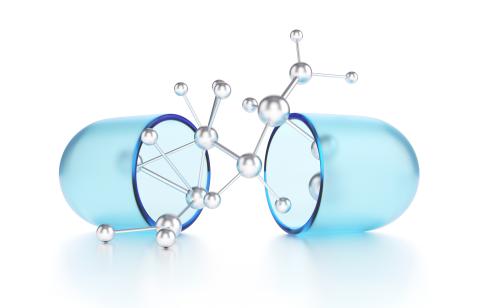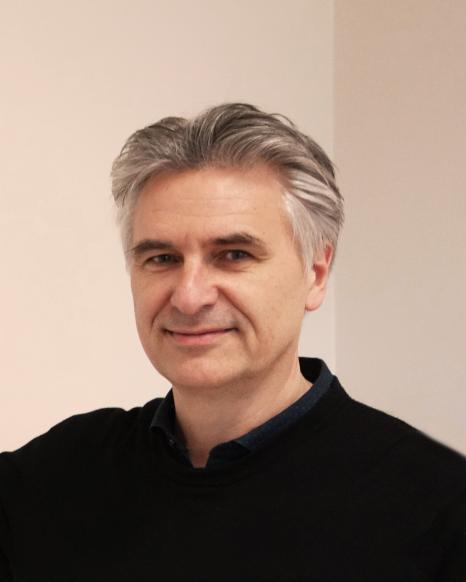
Frédéric Taran: the chemistry of living cells
Frédéric Taran is Director of Research at CEA and Head of the Bioorganic Chemistry and Marking Department (SCBM) within the Medicines and Technologies for Health Department (MTS - Univ. Paris-Saclay, CEA, INRAE). Where chemistry meets biology, his speciality is bioorthogonal chemistry and its applications in the field of healthcare, in particular for cancer diagnosis and treatment. Coordinating several different research projects both domestically and internationally, Frédéric Taran is a major player in this community, distinguished in 2023 by the Seqens Prize from the French Academy of Sciences.
"My core business is organic chemistry," confides Frédéric Taran. "I've always been fascinated by the living world, pursuing the dream of one day reproducing the millions of simultaneous chemical reactions that characterise the functioning of a cell." Taran is a long-standing member of the Bioorganic Chemistry and Marking Department (SCBM), one of the three departments of the Medicines and Health Technologies Department (MTS - Univ. Paris-Saclay, CEA, INRAE), which employs almost 70 people. He defended his thesis there in 1996 and was recruited in 1998, on his return from the United States and his post-doctorate at Texas A&M University. "I worked with Sir Derek Barton, a British chemist who won the Nobel Prize in 1969. Together with Charles Mioskowski, my thesis supervisor, he was one of the people who meant the most to me." A few years later, Frédéric Taran took over as head of the Carbon-14 Marking Laboratory and then of the SCBM.
Chemistry for the living world
In the early 2000s, the researchers Karl Barry Sharpless and Morten Meldal, from the USA and Denmark respectively, invented a new kind of chemistry, named "click" in reference to its principle of joining two "objects" (molecules, proteins, nanoparticles...) together. The concept is not new to organic chemistry. The important point is to make this phenomenon durable and effective in all solvents, whatever the structural complexity of the objects. A few years later, an American researcher, Carolyn Bertozzi, succeeded in applying click chemistry to living organisms. In 2022, these three chemists were awarded the Nobel Prize in Chemistry for the development of "click chemistry" and so-called bioorthogonal chemistry. "It's called bioorthogonal chemistry in reference to its orthogonal operation in biology. In other words, we need to create the conditions for association between artificial chemical functions in natural environments," explains Frédéric Taran. Dazzled by this discovery, Frédéric Taran immediately decided to apply this new chemistry to his own research. At the time, he and his team were working on high-throughput screening for therapeutic applications, the principle of which is to multiply manipulations by analysing them simultaneously in order to increase the probability of discovering new bioactive molecules.
Artificial chemistry in a natural environment
"Click chemistry is still a fairly new field," explains Frédéric Taran. "Its tools were born in the 2000s, but healthcare applications have only recently begun to emerge." Connecting two "objects" in vivo requires overcoming an impressive number of obstacles. You have to stop reagents from degrading, being metabolised or eliminated by the natural environment, and moreover, they should be biocompatible. In 2013, success was first achieved: Frédéric Taran and his colleagues discovered a new click reaction. Four years later, they succeeded in making the system truly bioorthogonal. They required two more years to make it extremely fast. In 2019, the team successfully completed its first in vivo click experiment, earning the researcher the Pierre Fabre Prize from the Society for Therapeutic Chemistry.
Targeted therapy applications
The research carried out by Frédéric Taran's team is currently supported by various different programmes. "The discovery that artificial chemistry can be made in a living organism has opened up incredible prospects for diagnostic and therapeutic applications, particularly in oncology. For example, when a patient undergoes imaging by ImmunoPET (the new-generation petscan), he or she is injected with an antibody. Instead of being radiolabelled as is currently the case (and to avoid radioactivity persisting in the body), a small click chemistry function is placed on it. The antibody binds to the tumour after two or three days. A complementary small molecule is then introduced into the patient's blood, this time radiolabelled with fluorine 18. It only takes a few minutes for the molecule to spread throughout the body, and if all goes well, to click onto the tumour, which will then be pinpointed very precisely."
Click or cut
In bioorthogonal chemistry, we can either link two objects or cut a molecule in half inside a human body. There are numerous applications in healthcare too. In 2019, Frédéric Taran and Sébastien Papot, a professor at the University of Poitiers, were the first to succeed in "exploding" a nanoparticle by bioorthogonal chemistry in a living environment. In this case, we do not inject an antibody, but a nanoparticle containing a drug. Equipped with one of the click chemistry tools, it joins together with the tumour, then cuts itself on contact with a second molecule injected in vivo. The trapped drug is then released into the body. "The challenge seemed impossible," recalls the researcher. “The moment when the results of the experiment confirmed our success remains one of the most extraordinary in my whole career, all the more so because it was shared with a very good friend."
Chemical imagination at the service of human health
For the time being, applications are developing more in the medical imaging sector, and less in emerging therapies such as antidotes and purifiers, which Frédéric Taran is currently working on. "The idea is to eliminate a drug that persists in the body very quickly by natural means, in the event of overdose for example. We'd be able to get things done faster if industry took more of an interest," confides the researcher. He himself gave his doctoral thesis a boost in 2013, when he founded SYNDIVIA, a biotech startup with a researcher from the University of Strasbourg, to use their discovery to improve the performance of anti-cancer drugs.
Today, Frédéric Taran continues to welcome young chemists from many countries to the SCBM, and passes on to them his undiminished passion for chemical molecules and the development of bioorthogonal chemistry tools for human health. "In addition to new diagnostic tools for targeted therapies, I imagine that within the next ten years or so, we'll be developing generic clearance agents, in other words purifiers that work as antidotes directed at whatever we want," concludes Frédéric Taran.

